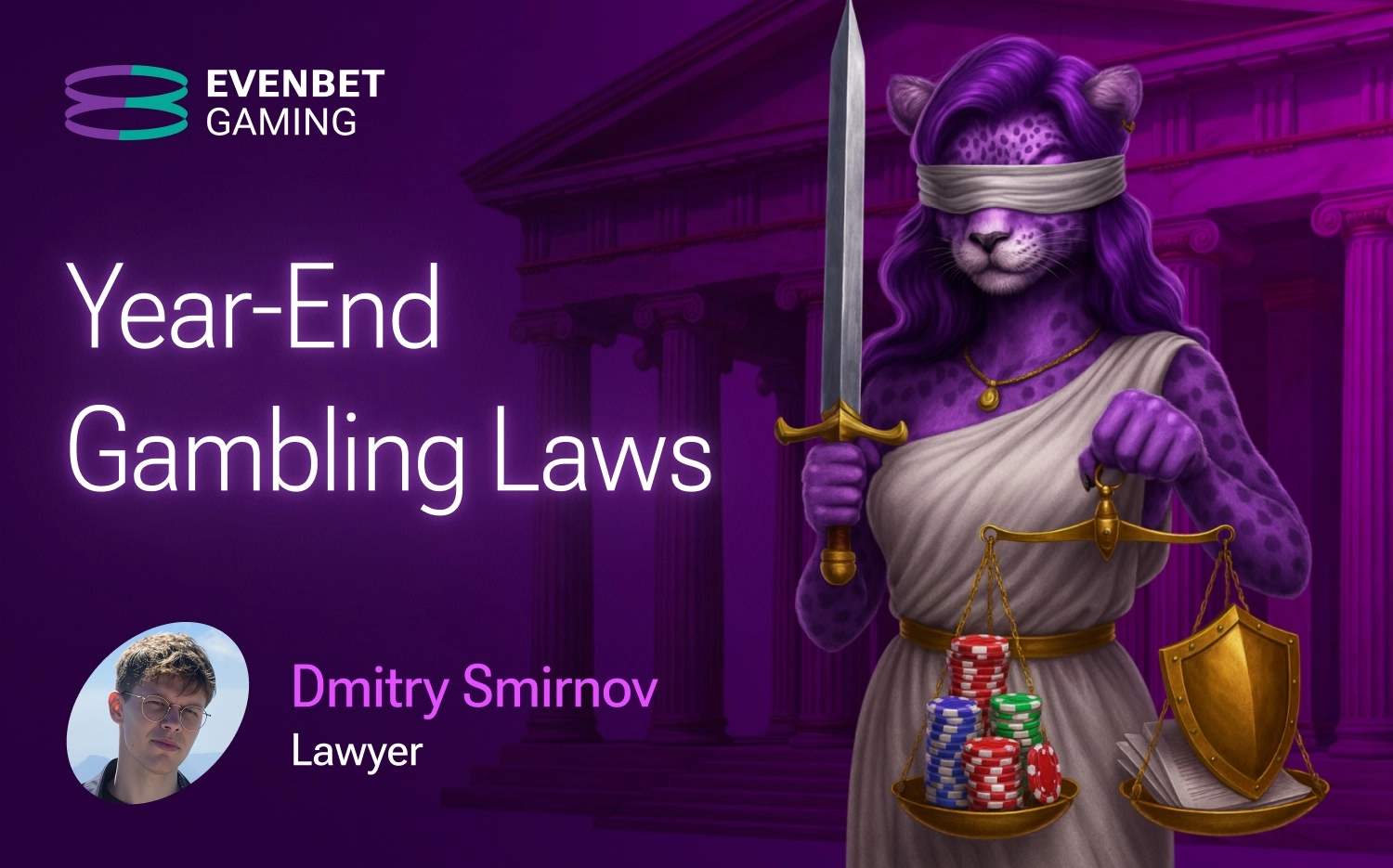It’s a fair question: why add gamification to poker when poker is already a game? But when we take a closer look at how players interact with online poker platforms over time, the potential of gamification becomes much clearer.
Even a game can benefit from additional layers of motivation, structure, and feedback — especially in a high-variance environment like poker. Thoughtfully designed gamification enhances how players learn, stay engaged, and come back for more. It helps new players build confidence, gives regulars fresh goals to pursue, and creates a more emotionally rewarding experience for everyone involved.
Across industries, from streaming platforms to grocery apps, gamification has proven its power to drive user behavior and loyalty. But in the context of online poker, its role is particularly nuanced — and potentially game-changing.

In this article, we’ll explore:
- What gamification is and why it works
- Why poker operators are turning to gamification to drive retention and revenue
- Practical tools and mechanics tailored for online poker
- Key metrics to measure impact and success
- Common risks — and how to avoid them through ethical design
Whether you’re already exploring gamified features or just considering your first move, this guide will help you understand the opportunities and limitations of gamification in online poker today.
What Is Gamification and Why It Works
Gamification is the use of game-like mechanics in non-game contexts — a concept that’s become a proven strategy for boosting engagement across industries. One of the most familiar examples is education: students tend to learn more effectively when material is presented through interactive challenges, goals, or points-based systems. But gamification works far beyond the classroom.
Its effectiveness is rooted in decades of behavioral research. In the 1970s, psychologists Richard Ryan, PhD, and Edward Deci, PhD, introduced Self-Determination Theory (SDT) — a foundational framework for understanding motivation. Their research challenged the conventional belief that external rewards (like money or prizes) are the most powerful drivers of engagement. Instead, they showed that people are more deeply motivated when three conditions are met:
- They can set and pursue goals autonomously
- They receive clear feedback on their progress
- Their achievements are visible and socially acknowledged
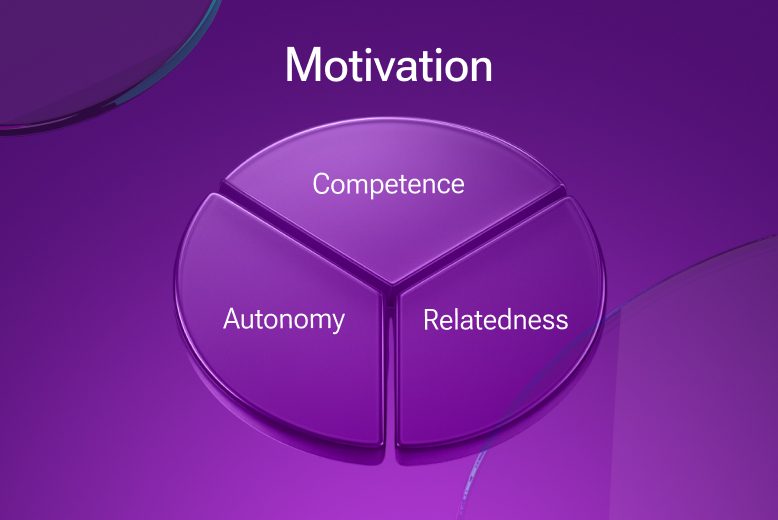
Later studies expanded on this idea with the concept of Flow, the mental state of full immersion in an activity. Flow occurs when a person is presented with clear, achievable goals, immediate feedback, and a challenge level that matches their skills — all of which are key principles behind effective gamification.
Another important insight: predictable, structured reinforcement tends to outperform flashy or randomized rewards. In many cases, a visible progress bar and clear milestone can be more motivating than the chance to win a jackpot. Players are more likely to stay engaged when they feel in control and can see their improvement over time.
In short, gamification isn’t about gimmicks — it’s about aligning product design with how people naturally stay motivated, learn, and grow. When applied correctly, it builds deeper, longer-lasting relationships between users and platforms — including online poker.
Why Online Poker Needs Gamification
When online poker first emerged in the early 2000s, players didn’t expect much more than a stable client and the ability to join real games from home. It was a tight-knit community of enthusiasts — people who played for the love of the game and didn’t need much beyond the core poker experience.
I was one of those early players. And I still smile at the long-running joke on old poker forums: “Poker only has two years left.” That line has been circulating since the early 2010s. But back in the day, the fear felt real. The concern? That as the proportion of professionals grew and recreational players dropped off, the entire ecosystem could collapse. Pros would win the money, casuals would lose interest and leave, and eventually the game would stop being sustainable for either group.
Some rooms tried to address this with hard segmentation — separating pros from amateurs through strict criteria. For example, limiting access to beginner tables based on VPiP, win rate, or how long a player had been registered. This kind of rule-based separation may have short-term effects, but it often comes at a cost: regulars feel alienated. And the truth is, skilled players are an essential part of a healthy poker ecosystem too. Without them, the game loses depth and challenge.
There’s a better way: soft balancing through gamification.
By introducing new formats and playful mechanics — like Spin & Go, Cash Drops, Bomb Pots, Mystery Bounty, or even game variants like 5-card or 6-card Omaha — operators can shift the dynamics without imposing rigid restrictions. These features inject fun and unpredictability into the game. They also increase variance, making outcomes harder to calculate and softening the edge of professional tools. The line between skill and luck gets blurrier — which helps level the playing field.
Beyond game formats, structured gamification layers — such as missions, achievements, or short-term progression goals — add another layer of balance and engagement.
Three key reasons gamification is becoming essential in online poker:
1. Taming Variance
A healthy poker ecosystem benefits from high variance. When outcomes are more unpredictable, it’s harder for professionals to dominate with pure technical edge — giving recreational players a better chance at short-term success and enjoyment. This encourages broader participation and creates a more dynamic player pool.
But with increased variance comes emotional volatility. Players can lose motivation after a string of unlucky hands, even if they made correct decisions.
This is where gamification plays a vital role: by introducing short-term goals with predictable rewards, you counterbalance the emotional impact of variance. Missions, progress bars, and milestone-based achievements give players a sense of structure and forward movement — even when they’re running below expectation at the tables. It’s not about reducing variance, but about helping players stay motivated through it.
2. Meeting Modern User Expectations
Fifteen years ago, online poker was a niche hobby for enthusiasts. Today, it’s part of a broader digital entertainment landscape — and the target audience has changed. Most players now grew up with mobile games, gamified apps, and interactive digital products. For them, game-like progression systems are the default, not the exception. A poker room without modern engagement mechanics feels outdated — or worse, unfriendly.
3. Increasing Session Value and Retention
When a player loses their stack or has a disappointing session, it often feels like the game is over — not just for the moment, but for the day. Without a clear reason to stay, many simply close the client and move on. Gamification changes that dynamic.
By introducing short-term objectives with tangible rewards — such as missions, streak bonuses, or milestone achievements — players are more likely to keep playing even after a tough run. These mechanics help shift the focus from “Did I win today?” to “Did I make progress?”
This not only boosts player satisfaction, but also extends session length and increases the chance of continued play. A user who would otherwise quit after losing may instead pursue a final mission, unlock a reward, or enter one more tournament — and in doing so, continue generating rake.
Gamification doesn’t remove the ups and downs of poker — but it gives players more reasons to stay in the game.
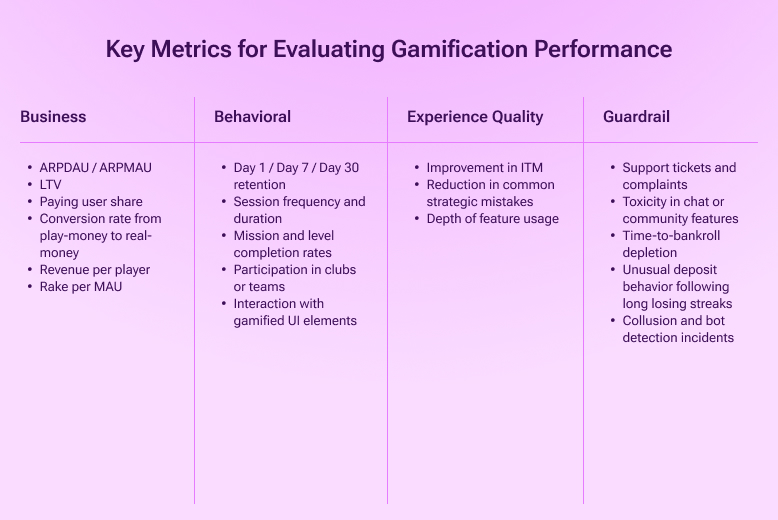
Gamification Tools in Online Poker
In 2025, gamification isn’t just a nice-to-have — it’s a core part of any serious poker room’s strategy. It’s not only a player acquisition tool, but more importantly, a retention engine. Done right, it helps build habits, deepen engagement, and increase lifetime value across all player segments.
For operators, the challenge is to design game-like mechanics that not only attract attention, but actually keep players coming back. It’s a creative, iterative process that requires testing bold ideas, collecting the right data, and optimizing based on real outcomes.
Below is a foundational toolkit of gamification mechanics tailored to online poker. Each can be adapted to suit your platform’s tone, audience, and monetization model — and together, they form a flexible framework for experimentation and long-term engagement.
Leaderboards
Leaderboards are one of the most powerful and widely adopted gamification tools in both poker and casino products. The most common implementation is a rake race — a time-limited competition where players earn points based on the rake they generate. Those at the top of the board receive rewards, often in the form of cash prizes, tickets, or bonuses.
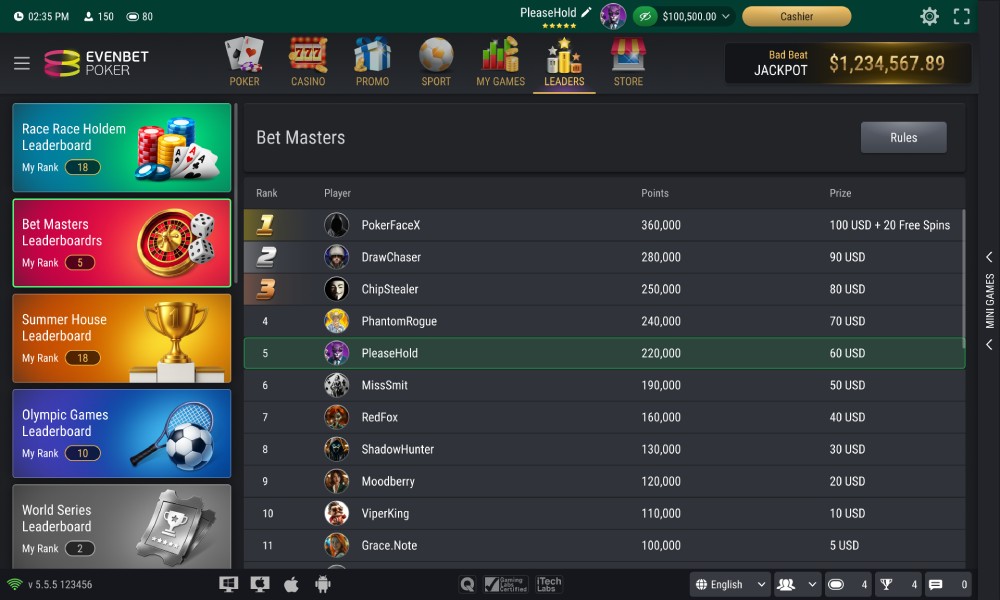
At first glance, leaderboards may seem like they simply add a competitive edge — and they do. But their true value runs deeper.
Leaderboards are a highly effective way to influence player behavior at scale. They don’t just encourage more play — they can be strategically designed to drive traffic toward specific formats, game types, or stakes that are most profitable for the room.
Their flexibility is a major strength. For example, you can configure a leaderboard to count only rake generated in 5-card Omaha games. This not only creates targeted demand, but also nudges players toward formats with naturally higher rake potential — such as variants with more hole cards.
When done right, leaderboards create a sense of urgency, purpose, and prestige — all while aligning player incentives with business goals.
Missions, Levels, and Status Tiers
Missions, levels, and achievement systems are core gamification mechanics that help reward specific player behaviors and build long-term engagement. Players are given clear objectives — such as “play 100 hands,” “hit 50 straights,” or “log in every day for a week” — and receive a visible reward upon completion.
The key to effective mission design is transparency and predictability. Players should instantly understand what they need to do, how far along they are, and what they’ll get for finishing. This clarity creates a sense of purpose and keeps users motivated, even outside of actual game outcomes.
Another best practice is gradual progression. Players should feel that they’re always moving forward — earning small wins regularly, not just grinding toward distant goals. One of the most effective implementations of this concept is Progressive Rakeback: the more consistently a player generates rake, the higher their status and the greater their rewards.
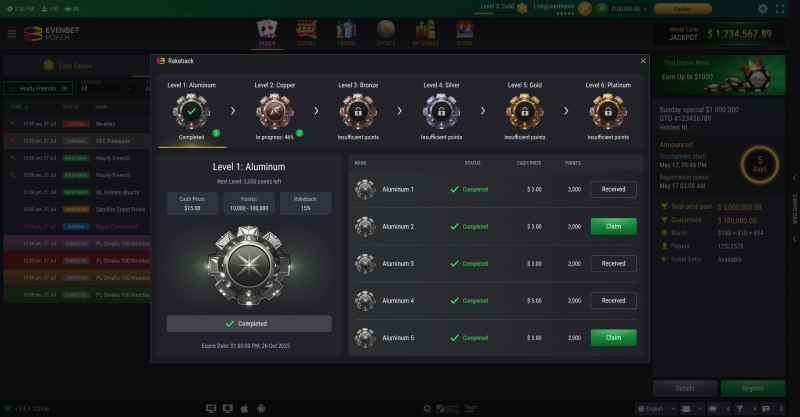
This model supports both short-term retention (through instant gratification) and long-term loyalty (through cumulative status tiers). And by tying progression to the behaviors that matter most to your business — such as volume, consistency, or trying new formats — you ensure that your gamification layer drives real value.
Bonuses and In-Game Currency
Bonus currency remains one of the most effective levers for both acquisition and retention in online poker.
On the acquisition side, welcome bonuses — awarded at registration or first deposit — are a proven tactic for converting new users. To prevent abuse, these bonuses are typically locked behind wagering requirements: players must generate a certain amount of rake before the bonus becomes withdrawable. This ensures that the bonus drives real gameplay and protects the room’s economy.
But bonus systems also play a crucial role in ongoing engagement.
By tying bonus currency to missions, streaks, or seasonal challenges, you create a soft incentive layer that encourages players to return and interact with specific features. In many cases, these bonuses can be spent in a dedicated in-game store — where players can purchase cosmetics like custom card backs, avatar frames, or table felt designs. Over time, this creates a sense of ownership and personalization: the player’s visual identity evolves, and with it, their emotional connection to the game.
Join our newsletter for exclusive tips to boost your poker room revenue!
Some stores also offer light utility upgrades, such as Rabbit Hunting, additional Time Bank, or special tournament access — features that add variety and optional perks without unbalancing gameplay.
When structured properly, bonus ecosystems help players feel rewarded for their time, extend session duration, and add long-term value without resorting to high-risk financial incentives.
Segmentation and Solutions for Different Player Clusters
Gamification only works effectively when it’s personalized to player needs, motivations, and experience levels. A “one-size-fits-all” approach can backfire — overwhelming casual players while leaving regulars disengaged. Below is a practical segmentation model with tailored gamification strategies for each cluster.
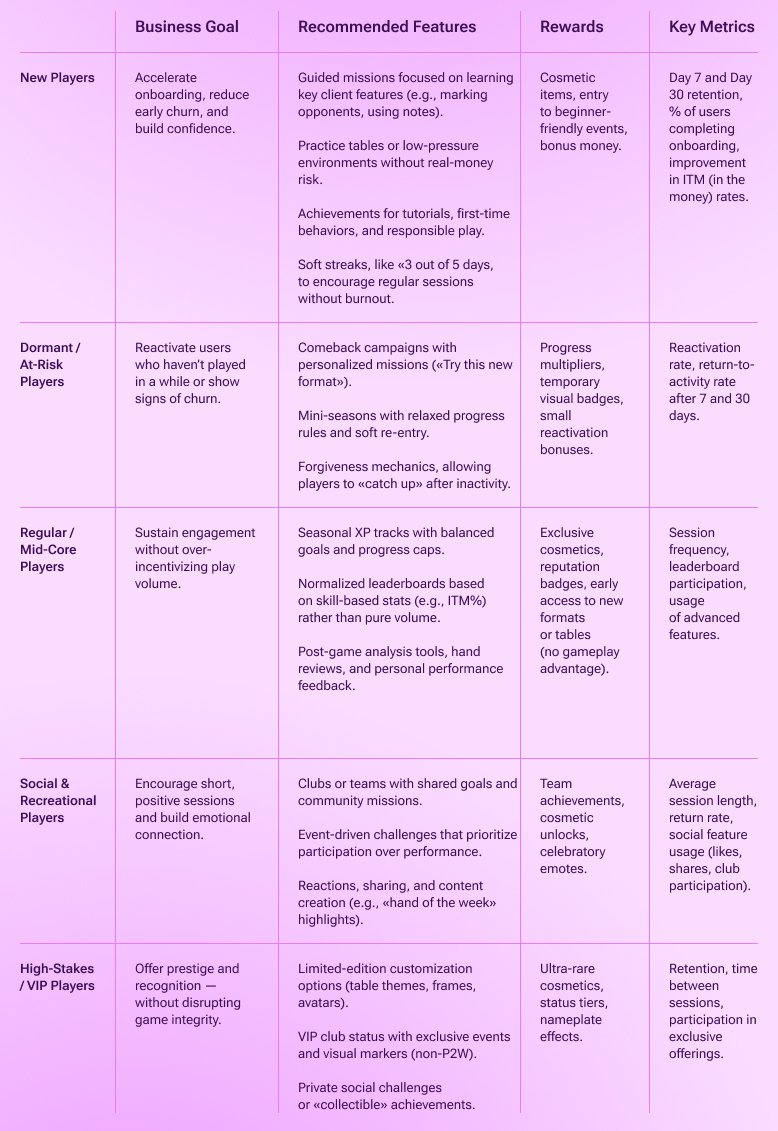
Potential Pitfalls of Gamification in Online Poker
Gamification is a powerful engagement tool — but if applied carelessly or excessively, it can become counterproductive. Many operators, especially in mobile and club-based environments, fall into the trap of overloading the user experience with layers of rewards, animations, and overlapping mechanics. Instead of enhancing motivation, this can lead to confusion, stress, and even player fatigue.
Oversaturation and Gameplay Fatigue
One of the most common issues is oversaturation — a situation where players are bombarded with notifications, bonus pop-ups, leveling animations, and seasonal missions all at once. While each mechanic may be well-intentioned on its own, the combined effect can disorient players and reduce their overall satisfaction.
This is especially visible in some poker clubs and social casino games, where years of feature layering often result in systems that are unintuitive for new users. A first-time player may be welcomed with level-up fireworks and bonus currency — without having made a single decision or played a hand. The intended emotional boost falls flat, because the rewards lack context and clarity. Instead of feeling rewarded, the player feels lost.
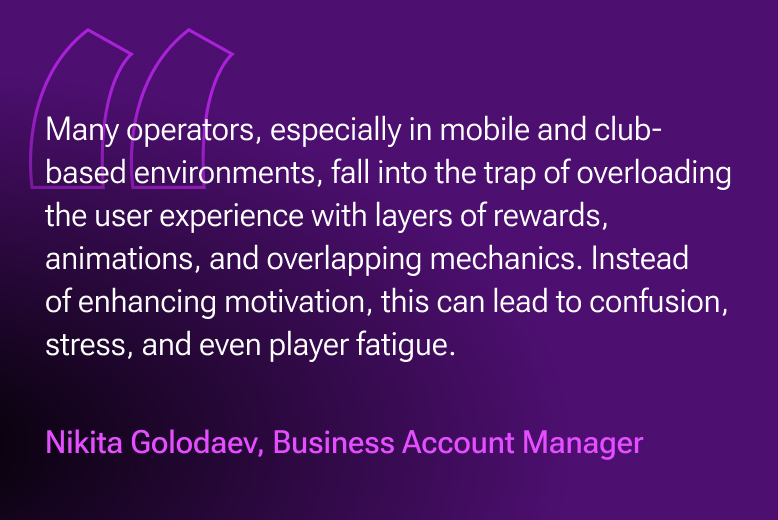
More broadly, constant goal-chasing and intrusive prompts can lead to psychological fatigue. The sense of “never enough” — always one more challenge, one more mission, one more streak to maintain — can turn play into obligation. This undermines long-term retention and creates the kind of burnout typically associated with aggressive microtransaction-driven mobile games.
Preventive Measures
- Invest in UX design. Gamification is not just a product decision — it’s a user experience decision. UX professionals should be involved in structuring how, where, and when rewards are presented.
- Test before scaling. Each new feature or promotional mechanic should be validated through A/B testing, with attention to user comprehension, satisfaction, and unintended side effects.
- Follow the “out-of-table” principle. Whenever possible, present progression, missions, and rewards in lobby screens, player profiles, or result summaries — not during hands. This avoids cognitive overload during gameplay and respects the core poker experience.
Gamification should enhance the player’s relationship with the platform — not overwhelm it. A thoughtful, data-informed approach ensures that new features feel motivating, not exhausting.
Pay-to-Win Perception
One of the most critical boundaries in gamification — especially in skill-based games like poker — is the line between cosmetic incentives and competitive advantage. When players can purchase or unlock gameplay advantages through bonus shops or promotions, the game risks becoming pay-to-win — and that has serious consequences.
Pay-to-win mechanics directly undermine the core principle of fairness that poker is built on. If players believe others can buy their way to better outcomes, the integrity of the platform is compromised. In some jurisdictions, this may also violate gaming regulations or consumer protection laws.
Even outside of legal concerns, pay-to-win systems are widely disliked — and often openly rejected — by gaming communities. They erode trust, alienate skilled players, and damage the long-term reputation of the platform.
Preventive Measure
- Do not implement pay-to-win mechanics! Limit bonus shop items and unlockable content to cosmetics, customization, or non-intrusive quality-of-life features (such as avatars, themes, or optional table animations). Avoid anything that provides in-game advantages or alters competitive balance.
Fairness must remain untouchable. The best gamification strategies enhance engagement — not distort the game.
Grind Pressure
When gamification mechanics focus too narrowly on volume or raw activity, they can incentivize irrational or unhealthy gameplay patterns. For example, players may start forcing marginal hands, overplaying weak positions, or entering every pot just to meet mission criteria. This behavior distorts the natural rhythm of the game and can degrade the overall player experience — particularly at lower stakes.
Preventive Measures
- Design flexible objectives. Avoid rigid “do X at all costs” missions. Instead, offer balanced choices, such as: “Win 3 pots without showdown OR reach ITM in a tournament.” This gives players room to act within their preferred style.
- Cap daily progress. Introduce soft limits on mission points or leaderboard gains per day to discourage unsustainable grinding.
- Audit missions pre-launch. Involve experienced players, coaches, or internal poker experts in evaluating how new missions affect in-game behavior and table quality.
- Use seasonal resets. Refresh leaderboards every 1–4 weeks to avoid long-term grind pressure and allow for healthy turnover of competition.
Regulatory Compliance Risks
Certain gamification features — especially those involving rewards, progression systems, or in-app purchases — may unintentionally violate local gambling laws or digital platform policies. This includes requirements around transparency, user data processing (e.g., GDPR), monetization, or even how promotions are presented within mobile apps.
Non-compliance can lead to fines, license denials, or app store rejections, all of which carry serious commercial consequences.
Preventive Measures
- Regularly review all gamified features against regulatory standards, including responsible gaming guidelines, advertising rules, and AML/KYC obligations.
- Align with platform policies for app distribution — such as Apple’s and Google’s requirements for in-app mechanics, reward disclosures, and age gating.
- Maintain documentation for audits and licensing bodies, including clear records of how gamification systems work and how they’re monitored for fairness.
Proactive legal and compliance review is essential — especially as regulatory scrutiny of gamified gambling products continues to grow globally.
Conclusion
Gamification in online poker is no longer just an experiment — it’s a strategic necessity. When implemented thoughtfully, it helps platforms increase player engagement, improve retention, create a more balanced ecosystem, and ultimately grow revenue. From missions and leaderboards to progression systems and cosmetic rewards, modern gamification tools give operators the flexibility to shape user behavior without compromising game integrity.
At the same time, effective gamification requires careful planning: aligning with user psychology, respecting regulatory boundaries, and avoiding design pitfalls such as oversaturation or unintended incentives.
At EvenBet Gaming, we understand both the power and complexity of gamification. With over 20 years of experience in iGaming, we offer a robust poker platform equipped with a wide range of promotional and gamification tools — fully customizable to your business needs.
More importantly, our team of experts works closely with operators to help them design, launch, and optimize features and promotional campaigns for maximum impact — including financial performance.
Whether you’re launching your first leaderboard or fine-tuning a mission system for a mature audience, we provide not just the technology, but the strategic support to ensure success.





 Upd: 14 October 2025
Upd: 14 October 2025  Windows
Windows  macOS
macOS  iOS
iOS  Android
Android 







